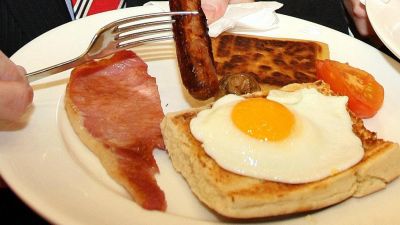Cost of Ulster fry reaches highest level since 2014

The price of an Ulster fry is now at its highest level since March 2014.
Ulster Bank’s Ulster fry index – which looks at the average inflation rate of bacon, pork sausages, butter, margarine, coffee, tea, milk, eggs, tomatoes and mushrooms – found that that the ingredients used to for a cooked breakfast rose by 6.4% from last year.
Ulster Bank’s chief economist Richard Ramsey warned the war in Ukraine is likely to cause even bigger rises over the next 12 months.
“The fact that we are now in a new cost-of-living crisis means that creating understanding of price rises and cost pressures and where they are coming from is essential,” he said.
“What the Ulster fry index is telling us is that the prices of everyday items like milk and bread are rising really strongly at a time whenever households are also having to contend with big rises in their household energy bills.
“The reality though is that the index is only going to go one way in the foreseeable future, and that is up.
"Given the surge in energy prices already, alongside the disruption to the global food supply-chain stemming from the war between Russia and Ukraine, the Ulster Fry Index is expected to experience double-digit inflation over the next 12 months. This would see the Ulster Fry Index hit a new record high.”
But while the costs of the ingredients are going up, the bank has warned profits for farmers are going down.
“Undoubtedly, farmers in Northern Ireland are operating through very challenging times and the pace and scale at which input costs continue to rise is alarming,” said Ulster Bank’s Senior Agriculture Manager Cormac McKervey.
“Farm gate prices for beef, lamb, grain, and milk are at an all-time high but margins remain static and, in some cases, are actually lower than this time last year.
“Many farmers are having to manage their cash flow extremely carefully, and while profitability has yet to dip, certain sub-sectors of the industry are being exposed to greater risks. Pig farmers are facing the most significant impact with input costs rocketing and the price for pork falling throughout the year.”